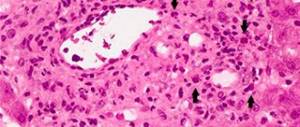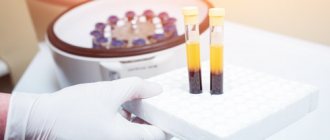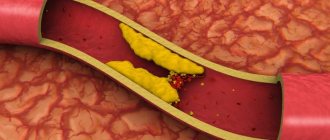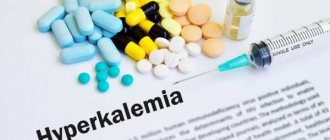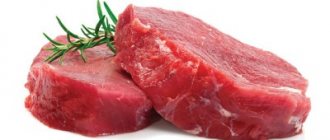Normal blood concentration
The albumin content in the body changes with a person’s age:
- up to 14 years - 38–54 g/l;
- 14-60 years - 35-50 g/l;
- over 60 years old - 34-48 g/l.
In addition to albumin, there is also a protein called globulin in the blood. Its amount is slightly less than the amount of albumin. It is these two fractions that make up the total protein composition in the body.
The condition when albumin is low in the blood is called hypoalbuminemia. As a rule, at the same time there is an increase in globulin levels. This symptom is called dysproteinemia.
Why are albumin levels needed?
Tests are taken if necessary:
- identify the causes of edema;
- select a treatment regimen and adjust the diet in patients with severe disorders of the liver and kidneys;
- predict the condition of seriously ill elderly patients.
Since the composition of the protein is quite homogeneous, it is not its quality that matters, but its concentration in the blood, which is determined by the number of grams in one liter. Depending on age, the level of albumin in the blood may change, but the gender of the person does not matter.
- children under 14 years old - 38–54 g/l;
- adults under 60 years old - 35–55;
- from 60 and older - 32–46.
A protein test is often taken along with other liver tests. Abnormalities serve as a test to help assess the functionality of the liver. A reduced rate may indicate organ pathology.
It should be remembered that at levels below 30 grams, edema may appear in adults. If the readings are not higher than 20–25, an intravenous infusion of a ready-made albumin solution is prescribed.
Main functions
To fully understand what happens in the human body when albumin is low, it is necessary to clarify the role of this protein structure. Its main functions are presented below:
- Regulation of osmotic pressure, due to which blood flows through the vascular bed without entering the cells. This prevents their swelling and destruction. It also prevents liquid from penetrating into the tissue.
- Energy reserve in the body. With insufficient carbohydrate intake and depletion of fats, albumin is destroyed for the body's energy needs.
- Some substances are able to move in the blood only when bound to albumin. These are fatty acids, vitamins, some hormones, antibiotics.
- Maintaining acid-base balance.
- Reducing the negative impact of free radicals on the body.
What is albumin - what is it responsible for?
Albumin is the most numerous fraction of proteins in blood plasma. In addition, fibrinogen and globulins are abundant in serum. They are produced by hepatocytes, which are liver cells that take up and convert amino acids into proteins.
The main task of albumin in blood serum is to maintain normal circulating blood volume by preventing the penetration of fluid from blood vessels into tissues by maintaining appropriate oncotic pressure and retaining water within the blood vessels.
Albumin prevents swelling and is also responsible for the transport of hormones, bile dyes and fatty acids, vitamins, ions such as calcium and magnesium, and drugs. It also influences the maintenance of appropriate pH levels.
Reasons for the decrease in level
All causes of low albumin in the blood can be divided into several groups:
- associated with insufficient protein intake;
- arising as a result of impaired absorption;
- with insufficient protein synthesis;
- increased need for albumin;
- excessive loss of protein.
Insufficient protein intake in the body occurs, as a rule, with too strict diets and fasting. This problem is also typical for vegetarians, since the largest amount of protein is found in meat.
Impaired absorption of albumin occurs in inflammatory diseases of the gastrointestinal tract (duodenal ulcer, Crohn's disease, ulcerative colitis, enteritis) or in the absence of enzymes that digest protein (pancreatitis, congenital trypsin deficiency).
An increased need for albumin occurs during pregnancy.
A decrease in protein synthesis occurs in severe liver diseases due to the development of liver failure. This is possible with hepatitis of various etiologies, alcoholic cirrhosis, primary biliary cirrhosis (genetic pathology).
Too much protein loss is possible in several cases:
- excessive excretion of albumin in the urine with increased permeability of the capillaries of the kidneys (glomerulonephritis);
- with excessive protein secretion by the renal tubules (Fanconi syndrome).
Reasons for increasing protein
If the result of the analysis showed that albumin is increased, then the patient is diagnosed with hyperalbuminemia.
The most common reason for an increase in protein is dehydration. This can be encountered with prolonged intestinal upset, vomiting, and heat stroke.
If a large volume of fluid is lost, human blood thickens, which negatively affects the condition of the patient’s entire body.
An increase in the amount of albumin in the blood plasma of sick people is less common than a decrease.
Developed hyperalbuminemia can provoke other diseases, for example, the formation of blood clots.
Other developing diseases can increase the amount of albumin in the blood plasma:
- infectious infection - cholera, dysentery and other diseases accompanied by intestinal disorders;
- intestinal obstruction caused by a tumor, prolonged constipation or other reasons;
- autoimmune pathologies - lupus erythematosus, Crohn's disease, and so on;
- diseases of the hormonal system - diabetes mellitus, thyroid pathologies;
- burn of a large surface of the skin;
- treatment with certain medications - an increase in albumin can be caused by corticosteroids or Bromsulfalein.
You can reduce the amount of albumin in the blood using some non-drug methods.
To get the desired result, you should change your usual lifestyle:
- you need to give up cigarettes. Long-term smokers often suffer from high blood pressure. You should give up a bad habit gradually to avoid stress on the body;
- exclude alcohol from the diet, since the liver, damaged by the breakdown products of alcohol, is not able to effectively synthesize proteins;
- adhere to a healthy diet;
- drink 2-3 liters of clean water throughout the day. The liquid will not only reduce albumin in the blood, but also avoid the occurrence of blood clots.
In case of severe diseases accompanied by an increase in albumin in the blood serum, the help of a doctor is necessary. Sick people should not self-medicate or select medications.
Transient decrease in protein levels
All of the above conditions, when albumin is low, are characterized by their duration. Most of them require long-term treatment. But there are cases when the protein level decreases briefly and quickly returns to normal after the cause is eliminated. In these conditions, a decrease in albumin is associated with increased breakdown. Such diseases include:
- acute and chronic infectious diseases;
- large blood loss;
- serious injuries;
- large area burns;
- inflammatory diseases of the skin;
- extensive wounds;
- heart failure with the development of edema;
- decreased oxygen supply to tissues (hypoxia).
Symptoms
The main sign that albumin is low is the development of edema. There are several criteria that help distinguish edema with a reduced amount of protein from those that develop with heart failure. The former are characterized by their appearance starting from the top: under the eyes, on the face, then on the arms, torso, and lastly on the legs. They appear in the morning, immediately after waking up. The skin over the swelling is warm to the touch and pink in color.
Cardiac edema appears at the end of the day. In the initial stages, they develop on the legs, only in rare cases reaching the face. The skin over them is cold and cyanotic.
In addition to edema, symptoms characteristic of the main course of hypoalbuminemia occur. Since most often the reason that albumin in the blood is low is kidney disease, it is this that will be discussed further.
Glomerulonephritis is a kidney pathology of an autoimmune nature. It causes excessive loss of protein in the body due to increased permeability of the tubules of the renal capillaries. A decrease in the level of albumin in the blood with this pathology is one of the components of nephrotic syndrome. This syndrome is also characterized by:
- increased blood cholesterol levels;
- massive swelling throughout the body;
- dysproteinemia;
- slight traces of blood in the urine.
Diagnostics
To determine low albumin levels, diagnosis begins with a detailed conversation. The doctor finds out the patient’s complaints, how long he considers himself sick, and how the symptoms developed. You also need to find out what diseases your closest relatives had, since some reasons that albumin is low are hereditary.
After a conversation with the patient, the doctor begins an objective examination. When diagnosing hypoalbuminemia, it is especially important to check for edema. To do this, the doctor presses his thumb on the skin of the front surface of the leg so that the finger touches the bone. Then he slowly removes it. If there is a hole in the skin, it means there is swelling.
Among laboratory methods, the most important is a biochemical blood test. To increase the efficiency of the study, the level of albumin is determined together with globulins and, of course, total protein. A decrease in albumin level below 35 g/l indicates hypoalbuminemia.
A general urinalysis and an analysis to determine daily protein levels are also required. The presence of the latter in the urine is called proteinuria. This is a clear sign of kidney pathology.
Non-drug treatment
Treatment of the causes of low albumin can be carried out with the help of medications, as well as non-drug methods.
The latter should include changes in diet. This involves eating foods that contain large amounts of protein. These are products such as:
If inflammatory diseases of the gastrointestinal tract are diagnosed, the diet includes foods that protect the mucous membrane of the stomach and intestines. These are lactic acid products, flax seeds.
Drug treatment
If a condition in which albumin is low persists for a long time or is accompanied by edema, you should definitely consult your doctor. He will prescribe additional examination methods and appropriate drug therapy. As a rule, the choice of drug group depends on the cause of the decrease in albumin.
Thus, in case of autoimmune damage to the kidneys and liver, glucocorticoids and cytostatics are prescribed. They inhibit the immune response and the production of antibodies directed against the body's own cells.
In the presence of viral hepatitis, antiviral drugs and hepatoprotectors are prescribed.
If the patient suffers from an infection, he is given droppers with an electrolyte solution to restore the water-alkaline balance.
In case of massive blood loss, whole blood and plasma transfusions are possible.
In addition to eliminating the cause of low albumin, medications are prescribed that can reduce the severity of edema syndrome. Diuretics are used for this. They increase diuresis, helping to increase fluid excretion by the kidneys.
Prevention
Low albumin is a serious syndrome that requires painstaking diagnosis and treatment. Therefore, it is much easier to prevent its development than to cure it. To do this, you need to take the following measures:
- promptly treat infectious processes and autoimmune diseases;
- monitor your diet to ensure it contains enough protein;
- undergo a medical examination regularly (at least once a year), taking a biochemical blood test to determine protein levels.
If you follow these simple rules, you can significantly reduce the risk of developing hypoalbuminemia.
source
Carrying out analysis
How is the study of such an indicator as serum albumin carried out?
A blood test for albumin should be taken on an empty stomach. Eating the night before or immediately before the test can lead to falsely inflated results.
To do this, venous blood is taken and collected in a test tube containing sodium citrate (a substance that prevents blood clotting).
Further research is carried out in the laboratory. The resulting blood is centrifuged, the plasma is separated, and the resulting residue is studied.
The distribution of blood protein into fractions is carried out using electrophoresis. Under the influence of electric current, proteins are distributed throughout the field of study. Based on their distribution, a special graph is constructed indicating the concentration of various fractions.
Albumin level in blood
Please note that normal albumin values may vary from laboratory to laboratory. The indicators depend on the sensitivity of the test systems that were used in the biochemical blood test. The following standards are considered generally accepted:
Albumin is considered low if its concentration is less than 35 g/l. Although in children under 5 years of age the indicators may be slightly below this limit. The reason is the inferiority of liver cells. This condition is not dangerous and does not require treatment. As children grow older, albumin levels gradually reach adult levels. In general, indicators below the lower limit of normal can be considered reduced.
Why does serum albumin decrease?
Hypoalbuminemia can be primary or secondary. In the first case, low albumin is directly related to liver dysfunction. The secondary form develops against the background of diseases of other organs. The level of protein fractions can also be affected by:
- ibuprofen-based medications;
- antibiotics for tuberculosis;
- other anti-inflammatory drugs.
Non-pathological causes of hypoalbuminemia include erroneous interpretation. As a result, total protein in a biochemical blood test may be either low or high. The reason is often improper preparation for the study. Then the doctor can order the test again. All causes of low albumin are divided into groups:
- insufficient intake of protein into the body;
- problems with protein absorption in the intestines;
- increased need for proteins;
- sudden loss of proteins;
- disorders of protein synthesis.
Low protein intake
The state of hypoalbuminemia is typical for vegetarians. They don't get enough protein because they don't eat meat. In the rest, the pathology is observed during fasting or following a low-calorie diet. When a person sharply restricts the caloric content of the diet, the lack of proteins is first compensated by the albumin fraction. Then its reserves are depleted, which leads to hypoalbuminemia.
Impaired absorption of protein fractions
A person can get enough protein from food, but if the body does not absorb it, the level will be reduced. The cause of absorption problems is inflammatory diseases of the gastrointestinal tract:
- Crohn's disease;
- duodenal ulcer;
- enteritis;
- inflammation of the peritoneum;
- volvulus;
- malignant diseases of the digestive tract;
- nonspecific ulcerative colitis.
Another reason is a lack of enzymes that are necessary to digest proteins. This condition can occur with the following pathologies:
- congenital trypsin deficiency;
- pancreatitis.
Increased need for albumin
This cause of hypoalbuminemia is common in pregnant women. The child needs many essential amino acids, which he receives from the mother’s body. Albumin in a woman’s plasma contains “in reserve” all the proteins the baby needs.
It is easier for a pregnant woman’s body to break down existing proteins than to process them from food. Hypoalbuminemia during pregnancy is considered normal. The level of this protein changes as follows:
- In the first trimester it decreases to 32 g/l.
- In the second it reaches the limit of 28 g/l.
- Shortly before birth it is 24-25 g/l.
Excessive protein loss
The body begins to quickly lose protein in emergency situations. In such cases, the amount of protein simply does not have time to recover. Severe losses of albumin are possible due to the following diseases:
- Fanconi syndrome. This is a condition in which the kidney tubules secrete excessive amounts of protein.
- Acute and chronic glomerulonephritis. The disease causes increased permeability of the capillaries of the kidneys. More protein fractions are excreted in the urine than should be present in a healthy person.
- Nephrotic syndrome. Causes increased excretion in urine not only of albumin, but also of individual protein fractions.
Deterioration of protein synthesis
The main reason for the decrease in protein synthesis is severe liver disease, which leads to liver failure. This is possible with the following pathologies:
- alcoholic cirrhosis;
- hepatitis of various nature;
- primary biliary cirrhosis;
- congestive heart failure;
- abnormal structure of albumin of a genetic nature.
If albumin is low, what does this mean?
If the level of albumin in the blood is reduced, then this quite often occurs in the case of extreme diets, fasting and insufficient consumption of protein foods. This usually happens if a person goes on a diet to lose weight and has anorexia. Exhaustion of the body, cachexia is also accompanied by a sharp deviation of albumin from the norm towards a decrease. But this may also indicate the presence of some pathological processes in the human body. For example, the following diseases:
- hepatitis of various types,
- cirrhosis of the liver,
- carcinoma,
- disorders in the gastrointestinal tract,
- loss of protein as a result of various injuries or extensive burns,
- various kidney diseases, especially chronic ones,
- nephrotic syndrome,
- malignant tumors,
- rheumatism,
- blood diseases,
- blood poisoning,
- fever,
- congestive heart failure,
- abuse of cigarettes and alcohol.
A decrease in albumin levels is observed in cases where a significant amount of various blood products and blood substitutes have to be transfused to the patient. As already mentioned, this indicator naturally decreases during pregnancy - the mother’s body shares its albumin with the developing fetus. A slight decrease in albumin levels can also be observed during breastfeeding. In infants, due to insufficient maturity of the liver cells, the albumin level is low, and this is a normal condition.
A low level of albumin in the blood can be caused by taking certain medications - ibuprofen, aziotropin, etc. Therefore, be sure to tell your doctor about all the medications you are taking. Also, low albumin can be a hereditary feature of a person.
Important: a significant decrease in blood albumin levels can lead to the development of pulmonary edema.
Banal dehydration immediately increases the amount of protein, this is how the protective mechanisms of human physiology work. Blood also thickens with prolonged diarrhea or uncontrollable vomiting. A reduced level of albumin indicates its unintended losses or insufficient production. This is a signal of serious illnesses, serious pathologies, which may include liver or blood diseases.
A normal whey albumin protein molecule must function for at least two decades to twenty days. All this time, protein important for the functioning of the body is stored in albumin. If a person begins experiments with fasting, then the body will still replenish the need for protein, but not from the food it does not receive, but from its own albumin. Thus, the reasons for the increase and decrease in albumin are sometimes associated with unfounded “amateur activity” in the field of reasonable nutrition. Also, the reasons for the increase and decrease in albumin can be explained by more joyful circumstances, for example, pregnancy. The expectant mother, perhaps without even knowing it, shares “building” material with the fetus, including albumin. The level of whey protein also decreases during another pleasant procedure associated with motherhood - breastfeeding. The reasons for the increase and decrease in albumin are often associated with an unhealthy lifestyle. Any habit that ruins health - smoking, abuse of alcohol-containing liquids - leads to a change in albumin levels. Heavy smokers can rest assured that their vital albumin levels are well below normal limits. People who do not spare their liver also cannot boast of a normal level of albumin, because it is in the liver that whey protein is synthesized.
Also, the reasons for the increase and decrease in albumin can be explained by hereditary factors. Genetic failures and heredity can cause a low amount of albumin in the blood. In addition, many severe pathologies of the kidneys or liver, including oncological processes, significantly change the normal limits of albumin. Among the causes may be lung diseases - pneumonia or severe influenza. A lower than normal amount of albumin in the plasma may also occur in cases of anorexia or dystrophy. This condition, or rather the lack of albumin, is commonly called hypoalbunemia. A decrease in albumin can be caused by medications, especially their long-term use. Azathioprine, phenytoin, dextran, ibuprofen group, isoniazid and others - all these drugs affect the albumin level.
The reasons for the increase and decrease in albumin are clarified not only by studying anamnestic information, but also with the help of specific tests. They are carried out in laboratories using colorimetry. The studies are carried out on an empty stomach, any physical activity and stress are excluded. This analysis is so specific that even strong pressure on the hand with a tourniquet can distort its results. A prolonged vertical position of the patient can also add about 10% to the results obtained. Such an assessment of the properties and general state of protein metabolism can clarify the reasons for the increase and decrease in albumin.
Albumin in blood serum accounts for approximately 60% of total protein. Albumins are synthesized in the liver (approximately 15 g/day), their half-life is approximately 17 days. The oncotic pressure of plasma is 65-80% due to albumin. Albumins perform an important function in transporting many biologically active substances, in particular hormones. They are able to bind to cholesterol and bilirubin. A significant portion of calcium in the blood is also bound to albumin. Albumins are capable of combining with various medications.
Hyperalbuminemia is observed during dehydration in cases of severe injuries, extensive burns, and cholera.
Hypoalbuminemia can be primary (in newborns as a result of immaturity of liver cells) and secondary, caused by various pathological conditions (including cirrhosis of the liver), similar to those that cause hypoproteinemia. Hemodilution may also play a role in reducing albumin concentrations, for example during pregnancy. A decrease in albumin content below 22-24 g/l is accompanied by the development of pulmonary edema.
Albumin and its level in the blood are important in the clinical diagnosis of a wide range of diseases. They are one of the main types of proteins (proteins) found in plasma.
An important indicator in a biochemical blood test, reflecting the protein composition, is the albumin-globulin indicator (blood coefficient). This is the ratio of albumin and globulin, which is normally 1.3-2.2.
Temporary decrease in albumin
The main causes of hypoalbuminemia relate to serious diseases or special conditions. They are observed for a long time and often require treatment. A separate group includes factors that temporarily reduce protein levels. After their elimination, the protein concentration is restored. The main causes of temporary hypoalbuminemia:
- extensive burns;
- acute and chronic infectious diseases;
- inflammatory skin pathologies;
- heart failure with edema;
- serious injuries;
- extensive wounds;
- hypoxia (lack of oxygen);
- severe bleeding.
What does albumin show in a biochemical blood test? Causes of high and low albumin
The level of albumin in the blood is determined using a biochemical analysis. Overestimated or underestimated indicators of a substance obtained by fractionation indicate a pathological process in the body.
Albumin or protein fractions are the most common indicators studied, because the substance reflects how fully the liver functions in protein synthesis.
Interesting fact: within 2 days the liver produces 15 grams of albumin, which provides benefits for up to 20 days.
Albumin: what is it?
Albumin is one of the main types of protein found in human blood. In the total amount of protein, albumin occupies approximately 60%, which shows its importance for the human body. The production of this protein occurs in the liver , so problems with its content in the blood may indicate a malfunction of this particular organ.
In addition, with a significant change in the amount of albumin in the blood, we can talk about a violation of the kidneys, or the presence of cancer and rheumatic diseases in a person .
Albumin performs a number of important functions :
- helps the body during fasting, as it accumulates amino acids. Under current conditions, they are spent first;
- is involved in the transport of various substances, including medications. With the help of albumin, bilirubin, bile elements, etc. are quickly delivered to the right place. Albumin also actively transports some types of antibiotics;
- protein is responsible for plasma osmotic pressure.
The liver produces about 15 grams of albumin every day. If there are problems in the body and serious diseases, a failure in the production of protein may occur, in which it becomes insufficient for normal life activities or, on the contrary, it begins to accumulate in the blood. Both conditions are abnormal and require treatment .
Albumin - what is it in a biochemical blood test?
Albumin is the main protein in the blood, making up more than half (50 to 65%) of the total plasma. It is synthesized by the human liver and is located in the peripheral blood, lymph, cerebrospinal and interstitial fluid. The life span of albumin lasts 15-20 days. The protein compound is low molecular weight, although the blood plasma protein fraction reserves more than 600 types of amino acids.
Based on the results of a biochemical blood test and the content of albumin in the blood serum, the doctor diagnoses the functioning of the kidneys and liver. A decrease in the concentration of a protein compound indicates the presence of rheumatism and malignant tumors.
In the picture: molecular structure of human serum albumin
Albumins are the most important elements in the blood serum, thanks to which the body functions fully.
Proteins circulate in the bloodstream and perform the following functions:
- The most important function of the protein fraction is the connection and transportation of various substances - hormones, acids, fats, bilirubin, calcium, tissue compounds.
- Responsible for maintaining blood plasma pressure , so that the fluid does not cause swelling and does not penetrate connective and muscle tissue.
- The reserve purpose is the preservation of protein elements . Albumin molecules are responsible for the preservation of amino acids necessary for the proper functioning of the body. During prolonged fasting, amino acid reserves are depleted.
Attention! Do not ignore your doctor’s recommendations regarding taking a biochemical test. Thanks to blood biochemistry, pathologies associated with albumin fluctuations are diagnosed. Timely testing helps prevent the development of pathology and prescribe effective treatment.
Instructions for Albumin
The instructions for Albumin indicate the following contraindications to the use of the drug:
:
- Chronic heart failure;
- Prolonged bleeding;
- Thrombosis;
- Chronic renal failure;
- Pulmonary edema;
- Hypersensitivity to albumin;
- Hypervolemia.
The drug should be used with caution by people with chronic heart disease, as there is a possible risk of the disease progressing to the acute stage. The instructions for Albumin say that the drug increases blood pressure due to its positive oncotic activity. Therefore, during the operation, after transfusion of the drug, bleeding may occur in the area of damaged vessels that previously did not bleed due to low pressure.
Albumin 5, Albumin 10 and Albumin 20 are administered intravenously by drip at 50 drops per minute (3 ml each). The daily volume of the solution is 100-500 ml. The dosage is selected individually, based on the severity of the disease and the age of the patient. Albumin 10 is usually prescribed according to the formula: 1-2 ml per 1 kg of weight. Droppers are given once a day or every other day. Albumin 20 is prescribed in severe cases and should not be used in elderly patients
.
Before starting the procedure, you need to check the bottle with the solution, it should not have sediment, the color should be transparent and clean. Otherwise, the drug cannot be used. If the bottle has been opened but not completely used, it must not be reused. Also, cracked or otherwise damaged vials should not be used.
Side effects occur extremely rarely. Allergic reactions are possible: Quincke's edema, urticaria, fever, low blood pressure, anaphylactic shock. If allergic reactions occur, you must immediately stop administering the Albumin solution and, without removing the needle from the vein, inject an antihistamine.
The use of Albumin by women during pregnancy should be carried out under the close supervision of a physician.
However, no harmful effects of the drug on the fetus were detected. The medicine can be combined with transfusions of other blood components and electrolyte solutions. Do not combine with amino acid solutions or alcohol solutions. The drug must be stored at a temperature of 2 to 10 °C in the refrigerator. Use only within the expiration date.
Many patients undergoing examination are interested in when a test for albumin in the blood is prescribed, what is it and under what circumstances does the content of the element change?
Albumin is a protein produced by the human liver. If a blood test determines a decrease or increase in albumin, then the occurrence of a disease or an exacerbation of a chronic pathology in the body should be suspected.
Albumin is one of the main proteins in plasma. Its content is 50–60% of the amount of all cellular components of plasma.
This compound is synthesized in the liver, and the period of activity of the protein cell lasts from 15 to 20 days.
Proteins are very important for the healthy functioning of the body. Albumin is the most important component of the protein fraction of blood.
Albumin performs the following important functions:
- binds and transports important compounds and substances in the organs and tissues of the body (micro- and macroelements, vitamins, hormones, lipids, bilirubin, acids) - this is the most important duty of albumin;
- maintains normal blood plasma pressure. Due to this, in an organism that has an optimal amount of albumin, the liquid remains in the bloodstream, does not penetrate through the walls of blood vessels into the muscle and connective tissue and does not cause swelling;
- reserve of protein elements. Albumin stores many essential amino acids, the presence of which is necessary for a healthy body. During prolonged fasting, these reserves are consumed.
Protein fractions in blood plasma are separate groups of elements, the violation of the optimal ratio of which can help diagnose the underlying disease, in contrast to the result of a study on total protein.
The most important value in the data obtained when assessing the general health of the patient is given to the level of albumin in the blood.
Any deviations in the protein content, up or down, indicate the development of diseases of the gastrointestinal tract, urinary system, autoimmune pathologies, cancer and other disorders of the functioning of body systems.
It is believed that the main importance of protein cells is the construction of cell membranes and components from essential amino acids.
But, in addition, this protein, as the most important component of plasma, provides the required amount of necessary elements in the organs and environments of the body, preventing the development of atherosclerosis, the formation of gallstones in the liver and gallbladder, edema and other pathological conditions.
Albumin: normal in blood
The norms of the albumin fraction in the blood range from 35 -33 g / l, this is much higher than the content of gamma globulin (8.0 - 12.0 - 17.0 g / l) and fibrinogen (2.0 - 4.0 g / l). l), and fibrinogen is difficult to detect in blood serum.
Protein standards are set depending on the age category of people. When taking the test, the normal level in plasma is the same in a man and a woman, so the doctor relies on the albumin norm based on the patient’s age.
Pictured: Proportions of proteins in human blood
Below are blood standards depending on the age category of patients:
- Children from birth to 3 years - 25 - 50 g / l;
- Children from 3 to 14 years old - 38 - 54 g / l;
- 14 – 60 years – 33 – 55 g/l;
- Elderly people over 60 years old - 34 - 48 g / l.
It is worth noting that: in people of mature age, a decrease in the level of albumin in the blood is noticed.
Table of norms by age
| Age | Albumin, g/l | α1, g/l | α2, g/l | β, g/l | γ, g/l |
| From 0 to 7 days | 32,5 – 40,7 | 1,2 – 4,2 | 6,8 – 11,2 | 4,5 – 6,7 | 3,5 – 8,5 |
| From 1 week to a year | 33,6 – 42,0 | 1,24 – 4,3 | 7,1 – 11,5 | 4,6 – 6,9 | 3,3 – 8,8 |
| From 1 year to 5 years | 33,6 – 43,0 | 2,0 – 4,6 | 7,0 – 13,0 | 4,8 – 8,5 | 5,2 – 10,2 |
| From 5 to 8 years | 37,0 – 47,1 | 2,0 – 4,2 | 8,0 – 11,1 | 5,3 – 8,1 | 5,3 – 11,8 |
| From 8 to 11 years | 40,6 – 45,6 | 2,2 – 3,9 | 7,5 – 10,3 | 4,9 — 7,1 | 6,0 – 12,2 |
| From 11 years to 21 years | 38,9 – 46,0 | 2,3 – 5,3 | 7,3 – 10,5 | 6,0 – 9,0 | 7,3 – 14,3 |
| After 21 years | 40,2 – 50,6 | 2,1 – 3,5 | 5,1 – 8,5 | 6,0 – 9,4 | 8,1 – 13,0 |
Normal blood albumin levels in women
Examining the biochemical analysis of the blood of a pregnant woman, a decrease in the concentration of protein in the plasma is noticed. The normal albumin content during pregnancy and lactation is 30-34 g/l.
After childbirth and at the end of breastfeeding, the level of protein compounds in the female body is normalized to the usual values.
Important information! An increase or decrease in albumin is caused by external and internal factors and indicates a pathogenic process in the body of a female representative.
Sometimes the lack of protein is caused by physiological characteristics, because proteins are released into the body of the expectant mother and reach the fetus. A balanced diet and proper rest help normalize albumin in a pregnant woman.
Normal blood albumin levels in men
The normal albumin level in middle-aged males is 33 - 55 g/l.
Albumin norm in children
Children's indicators also depend on age and the younger the child, the lower the albumin content in the blood:
- 0 - 7 days - 32.5 - 40.7 g/l;
- 7 days - 12 months - 33.6 - 42.0 g/l;
- 1 year - 5 years - 33.6 - 43.0 g/l;
- 5 - 8 years - 37.0 - 47.1 g/l;
- 8 - 11 years - 40.6 - 45.6 g/l;
- 11 years - 21 years - 38.9 - 46 g/l.
In boys and girls over 21 years of age, the concentration of protein compounds in the blood varies between 40.2 - 50.6 g/l.
Attention! Reference values in analyzes performed in different laboratories are different. If there is any doubt about the result of a biochemical test, it is suggested to re-donate blood in another medical institution.
Norm of protein fractions in blood serum
| Protein fractions in blood plasma | Norm, g/l | Group ratio, % |
| Total protein | 65 – 85 | |
| Albumen | 35 — 55 | 54 — 65 |
| α1 (alpha 1) globulins | 1,4 – 3,0 | 02.05.2018 |
| α2 (alpha-2)-globulins | 5,6 – 9,1 | 01.07.2013 |
| β (beta)-globulins | 5,4 – 9,1 | 01.08.2015 |
| γ (gamma)-globulins | 8,1 – 12,0 | 01.12.2022 |
| Fibrinogen* | 2,0 – 4,0 |
If albumin is elevated in the blood, what does this mean?
If, according to the results of biochemistry, there is a noticeable increase in albumin levels, hyperalbuminemia is stated, which most often indicates dehydration (dehydration) of the body.
Frequent attacks of vomiting and prolonged diarrhea contribute to a pathological decrease in fluid in the body. This causes blood thickening and has a negative impact on health.
Another reason for elevated protein levels is extreme fatigue.
Elevated albumin levels are rarely diagnosed.
But when hyperalbuminemia is diagnosed, the following diseases are diagnosed:
- damage to the gastrointestinal tract by Vibrio cholera;
- infectious diseases;
- intestinal obstruction;
- systemic lupus erythematosus;
- plasmacytoma;
- rheumatoid arthritis;
- pyelonephritis;
- diabetes;
- hepatitis, liver cirrhosis;
- chemical, thermal or radiation damage to the skin;
- long-term use of potent medications - glucocorticosteroids or bromsulfalein.
To reduce protein, it is recommended to follow certain non-drug methods:
- adhering to a diet with low-calorie foods , avoiding foods high in proteins and carbohydrates, focusing on boiled, stewed, steamed foods with the exception of fried, salty, spicy foods;
- stop drinking alcohol , since a kidney damaged by alcohol is not able to produce complete synthesis and absorption of proteins;
- stop smoking - heavy smokers have an increased risk of developing hypertension, which affects the excessive levels of albumin in the blood. Experts advise gradually quitting smoking, otherwise the condition may become more complicated;
- drink plenty of fluids - at least 2 liters per day to avoid dehydration and blood clots.
If there is no improvement in the analysis, the doctor prescribes the use of medications using drugs from the group of inhibitors or drugs that accelerate the regulation of cholesterol synthesis in the body.
Decrease and increase in indicators
An increase in blood protein is much less common than a decrease. The reasons for deviations from the norm depend not only on the disease, but also on the physiological state of the person. Albumin levels are reduced during pregnancy and lactation.
Hypoalbuminemia - a decrease in albumin - can be primary (manifests in children from the first days of life), and secondary: it is observed in people with various liver diseases, alcohol abuse and smoking.
The condition of hypoalbuminemia is observed in individuals who follow a low-protein diet. With anorexia and dystrophy, the protein concentration is also pathologically low.
Blood albumin may be low due to a hereditary disease. With analbuminemia, the protein concentration in the blood plasma is negligible. Patients suffering from this disease are prone to swelling, which may appear from time to time.
A decrease in albumin is associated with taking certain medications: Valproic acid, Ibuprofen, Dextran, Cisplatin, Phenytoin, etc. Oral contraceptives and anabolic steroids can also reduce protein levels in the blood.
A decrease in albumin can also be caused by the following diseases and pathological conditions:
- liver cirrhosis, hepatitis;
- kidney diseases (chronic renal failure, glomerulonephritis);
- thyrotoxicosis;
- oncological diseases accompanied by increased formation of antibodies;
- gastrointestinal diseases in which protein absorption is impaired;
- pathologies in which increased protein catabolism occurs: fever, infectious diseases;
- chronic heart failure;
- severe helminthic infestations;
- burns with significant blood loss;
- extensive blood loss.
If albumin in the blood is elevated, the condition is called hyperalbuminemia. An increase in protein often occurs due to dehydration. Hyperalbuminemia also occurs in the following diseases and conditions of the body:
- Dehydration due to severe injuries.
- Diffuse connective tissue diseases (systemic lupus erythematosus, etc.).
- Vomiting, diarrhea, accompanied by loss of fluid from the body.
An increase in protein in the blood occurs due to fluid replenishment or the introduction of albumin solutions. For elderly people, concentrated preparations, 10–15%, are administered with caution, gradually. A 20% solution causes stress on the cardiovascular system. An increase in blood levels may not be immediately detectable, since the protein is distributed not only in the vascular bed, but also in the connective tissue.
Blood is drawn from a vein, strictly on an empty stomach. It should be remembered that the level of protein in the blood is influenced even by the position of the person from whom the test is taken. When lying down, the rate can decrease by 10 percent.
The reasons for the decrease may also be a tight tourniquet on the arm, a stressful state, or physical activity that the patient experienced before.
Low albumin: causes
When the albumin content decreases and reaches 25 - 30 g/l, hypoalbuminemia is stated.
A reduced protein concentration indicates conditions such as:
- malignant process in the body;
- inflammatory kidney disease - diabetic nephropathy, nephrotic syndrome;
- diseases of the digestive system;
- leukemia, blood sepsis;
- dysfunction of the cardiovascular system;
- functional liver disorders - atrophy, cirrhosis, hepatitis;
- connective tissue damage;
- presence of severe injuries, burns;
- excessive water content in the body;
- pulmonary edema;
- severe blood loss, transfusion of blood substitutes;
- genetic pathologies due to which albumin levels decrease;
- prolonged fasting caused by adherence to low-protein and unbalanced diets.
Other reasons why albumin levels decrease:
- taking certain medications, especially in case of overdose;
- alcohol and tobacco abuse.
If your albumin level is elevated, do not panic and do not look for illness.
Reduced protein levels in biochemical analysis appear as a result of taking estrogen-containing drugs, fasting and the use of glucocorticosteroids.
After receiving the results, contact your doctor to schedule additional tests.
What are the main reasons for decreased serum albumin concentration?
A condition in which there is a decrease in plasma albumin below 35 g/l is called hypoalbuminemia. The leading clinical symptom of this pathological process is the development of oncotic edema, because a small amount of albumin becomes unable to hold the required amount of water within the vascular bed.
A decrease in albumin levels can be physiological, that is, caused by a special transient state of the body, or pathological, which reflects disturbances in the functioning of various organs and tissues.
Physiological hypoalbuminemia occurs in women in the 3rd trimester of pregnancy and during breastfeeding (due to the significant needs of the mother and fetus), and in infants (due to the immaturity of the sources of plasma protein formation).
The main causes of low albumin levels (pathological hypoalbuminemia) include:
- Lack of receipts. It is observed with prolonged fasting, tumors of the esophagus, and an unbalanced diet. Since it is albumin that plays the role of the first reservoir, in case of external deficiency it is used for the synthesis of various protein molecules depending on the needs of the body;
- Malabsorption syndrome. Malabsorption of nutrients can be caused by various reasons: hereditary pathology, inflammatory diseases of the gastrointestinal tract (enteritis), autoimmune diseases (Crohn's disease), enzymatic deficiency (pancreatitis), etc.;
- Genetic diseases. As an independent cause of a decrease in albumin concentration, it is extremely rare, but can lead to an almost complete absence of albumin in the blood serum (analbuminemia). In this case, the remaining protein fractions take over their functions;
- Kidney pathology (nephrotic syndrome). In this case, there is a decrease in the concentration of albumin in blood biochemistry below 20 g/l. The cause is damage to the glomerular apparatus of the kidneys (glomerulonephritis), in which the loss of albumin through the urinary system sharply increases. The diagnostic criterion is the detection of protein in the urine: more than 3.5 g/day;
- . Most often, hypoalbuminemia develops with liver cirrhosis of various origins: alcoholic, viral, toxic, cardiac. This occurs due to the defective functioning of liver cells (hepatocytes), which are not able to produce albumin in sufficient quantities. The amount of its daily synthesis decreases by 2-3 times: from 10-15 to 4-5 grams per day. However, changes in biochemical blood tests are diagnosed only 2-3 weeks after liver damage.
- Malignant neoplasms. Tumor processes actively have the properties of enhanced metabolism, which means they intensively consume nutrients. This may cause plasma albumin concentrations to decrease below normal levels. Direct damage to hepatocytes by a tumor or metastases from various organs is also possible.
- Diffuse connective tissue diseases. Accompanied by hypoalbuminemia as a result of direct and indirect (by damage to the kidneys and liver) metabolic disorders. Systemic diseases are characterized by a parallel decrease in albumin levels with an increase in the globulin fraction (systemic lupus erythematosus, dermatomyositis, rheumatoid arthritis), i.e. the albumin-globulin index is reduced;
- Burn disease. One of the first manifestations of extensive burns is a decrease in serum albumin concentration due to its generalized breakdown, which may require albumin transfusion;
- Massive bleeding. Lead to the rapid release of all types of protein beyond the circulatory system. The severity of hypoalbuminemia correlates with the rate of blood loss;
- Dermatological diseases (Lyell's syndrome, exfoliative dermatitis, severe forms of eczema). Accompanied by increased consumption of albumin, similar to burn damage to the skin;
- Taking certain medications (combined oral contraceptives, estrogen-containing hormones);
- Enhanced protein breakdown. Albumin is reduced due to increased intensity of metabolic processes in thyrotoxicosis, septic conditions, prolonged fever, Itsenko-Cushing's disease, preeclampsia, etc.
arterial hypertension and. The appearance of microalbuminuria indicates an unfavorable course of the pathological process.

